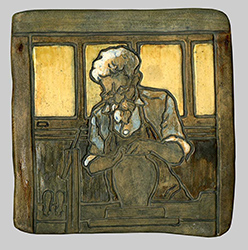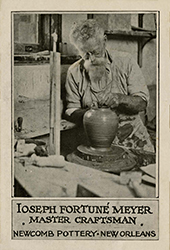Newsletter
The Two Red Roses Foundation (TRRF) recently acquired a Newcomb Pottery tile by decorator Leona Fischer Nicholson depicting the pottery’s beloved potter, Joseph F. Meyer (Fig. 1). This one-of-a-kind piece is the TRRF’s first acquisition of a hand-modeled Newcomb tile.
Established at the women’s college of Tulane University in New Orleans, LA, Newcomb Pottery was one of the leading Arts and Crafts enterprises of the late 19th and early 20th century. The pottery was primarily known for its bold vases ornamented with conventionalized motifs inspired by local Southern flora. The decoration was executed mainly in a cobalt blue, mineral-based glaze on bisque-fired clay, accented with yellow, green, and black glazes (Fig. 3).

Fig. 3 - Leona Fischer Nicholson, decorator, and Joseph F. Meyer, maker, for Newcomb Pottery, Vase with design of conventionalized freesia, 1908, glazed earthenware, TRRF Collection.
Newcomb’s art program was initiated by William Woodward, a graduate of the Massachusetts Normal Art School who had previously taught at the Rhode Island School of Design. Woodward hired Mary Given Sheerer of Covington, KY, trained at Ohio’s Art Academy of Cincinnati, to be the college’s first instructor. Under Sheerer, the pottery developed in stages; the school first offered china painting and glazing courses in 1894, followed by a pottery-making course in 1895. This culminated in a successful exhibition and sale of the students’ wares in 1896, a year which also marked the realization of a fully functional pottery.
Newcomb Pottery embodied the popular belief that the arts, and especially the world of crafts, offered ideal opportunities for women seeking careers. A majority of the teaching staff, designers, and decorators were women, but men were tasked with the manual labor of preparing the clay, throwing vessels on the wheel, and firing them in the kiln. Joseph F. Meyer was Newcomb’s head potter, joining the staff soon after he built the school’s kiln in 1895. He was responsible for throwing nearly all of Newcomb’s pots until his 1927 retirement.
In addition to thrown pottery, Newcomb had a robust clay modeling program spearheaded by Sheerer, where tiles, trays, jugs, plates, and other smaller vessels were hand-modeled, or formed without the use of the wheel. Sheerer was passionate about hand-modeled work because women created these wares themselves. Leona Fischer Nicholson, one of Newcomb’s most talented decorators, followed Sheerer’s pioneering spirit, frequently hand-forming pieces to reduce her reliance on Meyer for throwing. A Louisiana native, Nicholson first enrolled at the college in 1896, graduating in 1906. She later studied at Alfred University and received the prestigious title of Master Craftsman from the Boston Society of Arts and Crafts. While working for Newcomb, Nicholson maintained her own studio in New Orleans, firing her wares in the pottery’s kiln.
Perhaps in recognition of his significance to Newcomb, Nicholson created this approximately 5 x 5-inch tile with Meyer’s portrait. The image matches a postcard circulated by Newcomb that captures Meyer throwing a pot at the wheel in his studio (Fig. 2). Nicholson’s careful rendering of his likeness is a testament to her skills and also her respect for Meyer’s work. This tile will be on display, along with other works by Nicholson and Meyer, in the pottery gallery at the Museum of American Arts and Crafts Movement in St. Petersburg, FL.

